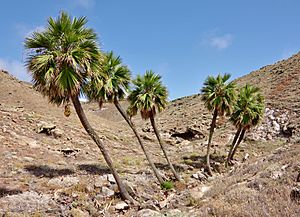Guadalupe palm facts for kids
Quick facts for kids Guadalupe palm |
|
|---|---|
 |
|
| In habitat, Guadalupe Island | |
| Conservation status | |
| Scientific classification | |
| Genus: |
Brahea
|
| Species: |
edulis
|
The Brahea edulis, also known as the Guadalupe palm, is a special type of palm tree. It is found only on Guadalupe Island in Mexico. This palm is a fan palm, which means its leaves look like large fans. It can grow quite tall, reaching between 4.5 and 13 meters (about 15 to 43 feet) high. On Guadalupe Island, these palms grow at heights between 400 and 1000 meters (about 1,300 to 3,300 feet) above sea level. This high altitude helps create unique "fog oases" on the island.
Where the Guadalupe Palm Lives
The Guadalupe palm is endemic to Guadalupe Island. This means it naturally lives nowhere else in the world. You can find a large group of these palms covering about 20 hectares (about 50 acres) on the northern part of the island. The island's steep hills and ocean weather create a special environment. It's one of the few true "fog oases" in North America. Even though Guadalupe Island doesn't get much rain (only about 133 mm or 5 inches per year), the fog and the shape of the land help keep the palms watered. This makes the area similar to the "lomas" (foggy hills) found in South America.
For a long time, there haven't been many new Guadalupe palm trees growing. This is because of a big problem: goats.
The Impact of Goats
For about 150 years, Guadalupe Island had a huge number of goats. In 1870, there were an estimated 100,000 goats! By 2000, there were still about 5,000. These goats ate almost all the young plants and tree saplings, including the baby Guadalupe palms. Because of this, the island's environment changed a lot. It went from being a green, lush place to a dry, rocky one. Weeds replaced the natural forests.
Below 800 to 900 meters (about 2,600 to 3,000 feet) above sea level, the Guadalupe palm was almost the only tree left. It grew in a main group and in smaller clusters in protected spots. Higher up, there used to be mixed forests with palms, Island Oak trees, and Guadalupe Pine trees. But these forests mostly disappeared because the other trees were pushed back to even higher areas where goats couldn't reach them as easily.
Protecting the Guadalupe Palm
The Guadalupe palm population slowly started to shrink in the mid-1800s. Other trees that used to grow with the palm, like the tall pine trees, were also affected. There were also forests of Guadalupe Cypress and California Juniper shrubs where the palms now grow. But the goats destroyed the cypress forests, and the juniper trees are now completely gone from the island.
Even though the Guadalupe palm is in danger in the wild, people grow it in other places, especially in California. This helps keep the species alive. In 2001, people started building fences around parts of the palm's habitat on Guadalupe Island. By 2005, almost all the goats were removed from the island.
Today, hundreds of Guadalupe palms still live on their island home. Since the goats are gone, young palms can finally start to grow again. This means the palm population will likely recover over time. The Guadalupe palm was better at surviving the many goats than other trees on the island. This is why it's still found in more places than the other native trees, which are now only in higher, harder-to-reach areas. However, the species is still quite rare. The IUCN (International Union for Conservation of Nature) considers it Endangered.
See also
 In Spanish: Palma de Guadalupe para niños
In Spanish: Palma de Guadalupe para niños


